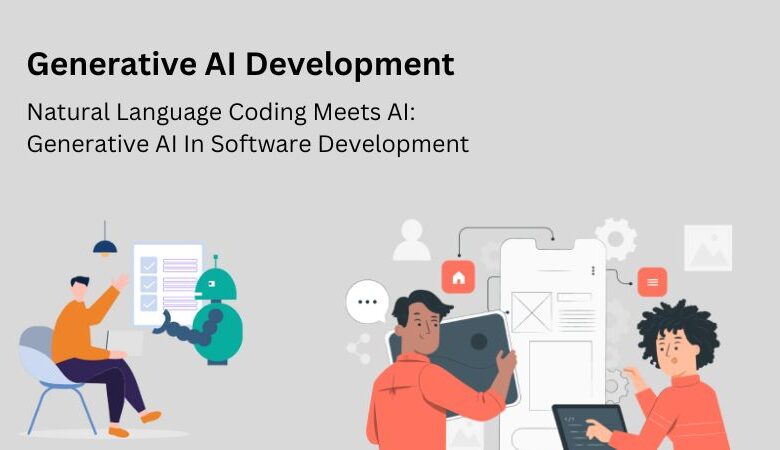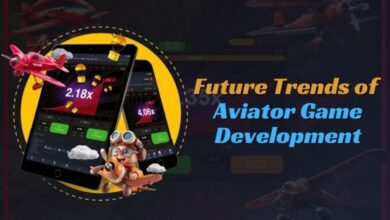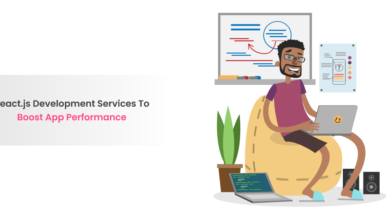Natural Language Coding Meets AI: Generative AI In Software Development

The field of software development is rapidly evolving with the emergence of new technologies like AI. One of the most promising areas where AI can revolutionize software development is through the use of generative AI models. Generative AI refers to AI systems that can automatically generate new content, like text, code, images, or audio, based on the data they have been trained on. When applied to software development, generative AI has the potential to automate repetitive coding tasks, generate code based on natural language descriptions, and even fix bugs automatically.
In this article, we will explore how generative AI is transforming software development and making coders more productive.
How Generative AI Works:
Generative AI software development models like GPT-3 are trained on massive datasets of text, code, or other content using deep learning techniques. They learn the patterns and relationships between words, lines of code, pixels in an image, etc. This allows them to generate new examples that statistically match the data they were trained on.
When it comes to code generation, generative models can take as input a natural language description of what the code should do, and output functioning code in a specified programming language. The model has learned the semantics and syntax of the language from all the code examples it saw during training.
Generative AI For Faster Coding:
One of the biggest promises of generative AI is to automate repetitive coding tasks, enabling developers to focus on higher-level logic and architecture.
Models like GitHub Copilot and TabNine act as AI pair programmers – suggesting completions for the next line or block of code as developers type. The suggestions drawn from the model’s training data can include boilerplate code, debugging corrections, and even new functions and algorithms. Developers just need to review the suggestions and incorporate the relevant ones.
This can hugely boost productivity when writing boilerplate code like HTML templates, CRUD APIs, config files, etc. The AI auto-completes the repetitive parts, while the developer provides the creative high-level direction.
According to GitHub, developers use up to 70% fewer keystrokes when coding with Copilot. The AI reduces grunt work and mental context switching.
Code Generation From Natural Language:
Even more futuristic is the ability of generative models to produce code from simple natural language descriptions. Instead of writing the code line-by-line, developers can just explain in plain English what they want the code to do.
For instance, “Validate this phone number format”, and “Create a for loop that prints numbers from 01 to 10”. The model translates the natural language into executable code in languages like Python, JavaScript, Java, etc.
This allows developers to prototype and test ideas much faster by offloading the translation of intent to code to the AI agent. It also lowers the barrier to coding by letting non-programmers contribute ideas more easily.
Debugging And Error Correction:
Debugging code accounts for a major chunk of programming time and effort. However generative AI models can automatically detect bugs and errors in code and suggest fixes based on their training.
For example, models like DeepMind’s AlphaCode are trained on lots of code examples and common bug fixes. So when presented with a buggy code snippet, they can analyze it and suggest corrections based on similar fixes in their training data.
This allows developers to find and squash bugs faster. The AI augmentation speeds up the whole process of code-build-break-debug. Generative AI can catch things that developers might miss when reviewing code and quickly suggest solutions.
An Overview of PactumJS: A Lightweight Contract Testing Framework
JavaScript-based API automation utility that can assist in API testing at all of the stages in a Test Pyramid can come to an end here with PactumJS, which is an open-source framework.
Converting Code Between Languages:
Another common programming task is porting code written in one language to work with another language. This includes migrating legacy systems to modern stacks or making projects work across different platforms.
Generative models can automate this process of inter-language code conversion using transfer learning. The model learns the syntax and grammar of multiple languages from examples during training. It can then convert code snippets between those languages while preserving functionality.
Code Summarization:
Generative AI can also help software teams manage large codebases by summarizing code functions and documenting them automatically.
Models can analyze code snippets and generate natural language descriptions explaining the overall logic and component relationships in plain terms. This improves documentation, makes it easier for new developers to understand legacy code, and reduces knowledge loss when developers switch projects.
Tools like Amazon CodeGuru, DeepMind CodeSuggest, and Bayes can autogenerate code summaries and comments based on context.
Good documentation is critical for managing institutional knowledge and technical debt in large software projects. Generative AI makes it easier to summarize complex codebases.
The Future Of Coding With Generative AI:
Generative AI promises to transform software development by automating repetitive coding, generating new code interactively, and amplifying human developer productivity. Coders can focus on high-level problem-solving while AI agents handle translation to executable code.
This will enable faster prototyping, easier cross-platform development, reduced bugs, better documentation, and more, resulting in huge gains in software productivity, quality, and developer satisfaction.
But it also raises important questions around ethics, security, accountability, and economics that must be addressed responsibly as these technologies become more powerful.
Conclusion:
Generative AI is at the cusp of fundamentally changing software creation by automating rote coding, generating new code interactively, and amplifying developer productivity. Models like Codex, Copilot, AlphaCode, and Claude can generate complete programs from natural language, autocomplete code, correct bugs, translate between languages, and summarize complex codebases. This promises to make programming more efficient, intuitive, and accessible to a wider pool of creators.
However, human oversight remains critical for evaluating the quality, relevance, and security of AI-generated code. More rigorous training, benchmarking, and hybrid models can help address current limitations around correctness, context, ethics, and safety. Responsible development of these technologies can truly realize the dream of more generative, collaborative coding – where AI makes programmers more productive while staying in service of human agency and priorities.
The meteoric progress in natural language processing and deep learning applied to code promises to revolutionize the creation of software – one of humanity’s most important coding languages that power our digital civilization.
Read More Also:
Strategies to Save Costs While Using Cutting-edge Digital Automated Tool
Let us check how Digital Process Automation can adopt automated tools to cut expenses





